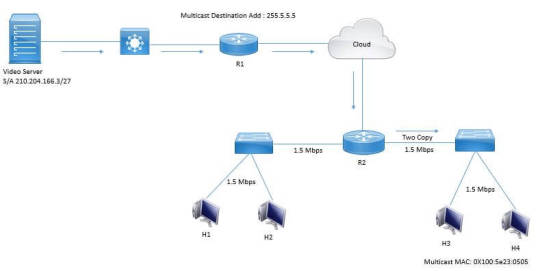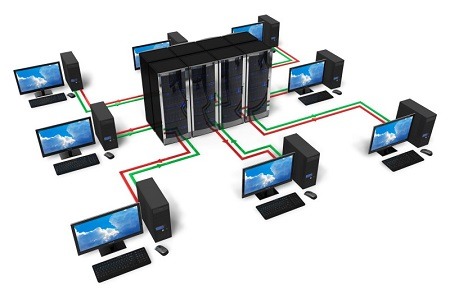#ComputerNetworking
Explore tagged Tumblr posts
Text
Computer Networking for Beginners: Build a Strong Foundation
Start your networking journey with EasyShiksha's beginner-friendly course. Learn essential concepts like TCP/IP, DNS, and HTTP, and gain hands-on experience in setting up and troubleshooting networks. Ideal for aspiring IT professionals and those preparing for certifications like CompTIA Network+ or CCNA.
0 notes
Text
Learn About Computer and fundamental of computer..with the crazy dev.
find more articles about web development, programming languages, computer network and many more.
0 notes
Text

Gain a comprehensive understanding of multicast networking essentials and their role in modern data center environments. Unlock new possibilities for efficient data transmission. https://www.dclessons.com/multicast-introduction
#MulticastIntroduction#NetworkingBasics#MulticastRouting#InternetProtocol#ComputerNetworking#ITBasics#Networking101#DataTransmission#NetworkInfrastructure#DClessons
0 notes
Text

Image Steganography . . . . for more information https://bit.ly/3CaeAgK check the above link
#onionrouting#networkneutrality#imagesteganography#topologies#routing#networking#network#computernetworking#javatpoint
1 note
·
View note
Text
We recently welcomed our customers to our optical cable production and testing base!
It was a fantastic opportunity to showcase our cutting-edge manufacturing lines, rigorous quality testing procedures, and unwavering commitment to excellence. From production to final inspection, every step highlights our dedication to delivering reliable, high-quality fiber optic products and solutions. Huge thanks to our customers for your trust and continued support — we’re excited to keep building the future together!
WhatsApp us: https://api.whatsapp.com/send/?phone=8618601637875&text&type=phone_number&app_absent=0






#Telecommunications#FTTH#fibertothehome#fiberoptic#FTTX#CATV#OSP#telecomengineering#survelliance#fiberopticcable#telecomconsult#outsideplan#cabling#computernetworks#smartcity#suntelecom#CustomerVisit#OpticalCable#QualityMatters#GlobalConnectivity
0 notes
Text

Advance Your Skills with Computer Network Course at George Telegraph
Join George Telegraph to advance your computer network skills. Learn from experts, gain practical experience, and boost your career prospects.
Visit Us at Our Official Website
0 notes
Text
Server Products Types: Understanding Size, Share, and Growth Trajectories
The global server market size is estimated to reach USD 175.29 billion by 2030, exhibiting a CAGR of 9.8% from 2024 to 2030, according to the recent reports of Grand View Research, Inc. Continued advances in emerging technologies, such as AI, IoT, big data, cloud computing, and 5G, and the growing adoption of innovative solutions based on these technologies across various industries and industry verticals are driving the demand for edge data centers in emerging economies.

Server Market Report Highlights
The rack segment is expected to register a CAGR of 11.3% from 2024 to 2030 in the server market. The segment growth can be attributed to the growing need for scalable data centers, high-density computing, and advancements in emerging technologies, such as IoT, cloud computing, and edge computing, creating vast growth opportunities for market players.
The large enterprise segment is expected to register a CAGR of 10.4% from 2024 to 2030 in the server market. Large enterprises are shifting their focus toward hosted application servers because they can handle workloads from multiple sites, typically from the same database.
The direct segment is expected to register a CAGR of 11.0% from 2024 to 2030 in the server market. Direct distribution can shorten lead times by sending goods directly to customers when they are ready for deployment. These benefits are expected to further supplement the growth of the direct channel during the forecast period.
The IT & telecom segment expected to register a significant CAGR from 2024 to 2030 in the server market. The IT industry has seen a growing implementation of cloud-based services over on-premises ones. Subscribers now get most services through a single service provider. Furthermore, mobile phones' constantly evolving multimedia capabilities are giving rise to new issues related to after-sales service delivery and execution.
Asia Pacific is anticipated to emerge as the fastest-growing region over the forecast period at a CAGR of 10.7% in the server market. The growth of the Asia Pacific market can be attributed to significant players in the region, including Baidu, Huawei Technologies Co., Ltd., Tencent Cloud, and Alibaba.com. Moreover, the region has been witnessing high growth in digitalization, especially in countries such as India.
For More Details or Sample Copy please visit link @: Server Market Report
As businesses move to private and public clouds, edge cloud, co-location facilities, and data centers have started utilizing software-defined networks (SDNs) and virtualization to facilitate the implementation of new data analytics models. However, having realized that the incumbent servers cannot handle the complex workloads, market players in the region are introducing new server designs with higher computational power.
The cloud computing sector attracts small enterprises by offering scalable infrastructure and services. Cloud computing also offers benefits such as on-demand self-service, broad network access, resource pooling, flexibility in terms of cost and time, transparency in the form of usage reports and timely updates regarding consumption rates, and cost updates to customers. It not only helps deploy business quickly but also considerably reduces operational costs. Since data security and recovery are critical concerns for small organizations, they prefer to deploy data on private clouds.
Furthermore, companies are utilizing big data analytics to provide the best services to their customers. Cloud services assist in optimizing business processes for small enterprises. These factors would further supplement the demand for servers in small enterprises during the forecast period.
Server platforms have evolved to incorporate features and capabilities once considered add-ons and were integrated only for advanced deployments. The architecture, product capability, and management and development tools account for a substantial share of the total ownership costs of owning the servers. The total ownership costs include the initial design, deployment, and recurring costs. The initial design and deployment costs cover the costs incurred on hardware, software, installation & setup, integration & testing, and initial deployment. On the other hand, the recurring costs include the costs incurred for technical support & consultancy, implementation, management & administration, monitoring & diagnostics, server downtime, and upgrades.
Additionally, the rise of advanced applications requiring particular settings and substantial computational power from users and providers is fueling the shift toward cloud servers for optimized performance. Businesses increasingly turn to virtual or cloud servers to improve their worldwide networking potential and reduce the expenses associated with operating and maintaining their IT systems. Furthermore, cloud service providers must allocate considerable resources to maintain cooling systems due to physical servers' higher heat output. Consequently, strategies like server leasing and virtualization have become more popular lately.
List of Major Companies in the Server Market
ASUSTeK Computer Inc.
Cisco Systems, Inc.
Dell Inc.
FUJITSU
Hewlett Packard Enterprise Development LP
Huawei Technologies Co., Ltd.
Inspur
Intel Corporation
International Business Machines Corporation
Lenovo
#ServerMarket#DatabaseServers#FileServers#PrintServers#ProxyServers#EdgeServers#ServerNetwork#ServerComputer#ComputerNetworks#ServerTechnology#CloudServer#ServerHardware
0 notes
Text
Distributed Computing System: Features, Types and Examples

Computer networks and distributed systems
Distributed computing system simulates computer operations using many computing resources in different locations. It uses several computers, servers, and networks to complete computing jobs of various sizes and purposes.
It works in the cloud. While distributed cloud computing and cloud computing are similar in theory, distributed cloud computing can expand cloud computing across multiple continents.
Small, distributed computer systems with nearby components can use LANs to link components. WANs connect components in geographically dispersed distributed systems. Distributed systems share information using a complex message-passing system over any network.
It uses shared memory and numerous components to solve the most difficult computer problems. It requires precise synchronization and lots of computer power to analyze data, share files, and cooperate towards a common objective.
10 Distributed Computing Uses
The following examples demonstrate how distributed computing is employed across industries and platforms:
Distributed Computing
It is commonly used in the communications business. Telephone and cellphone networks are peer-to-peer networks. Internet and email are distributed computing examples that changed modern living.
The field of computing is being transformed by advances in AI and machine learning. Both fast-growing technologies require distributed computing system. AI and ML algorithms need lots of training data and continuous processing power.
Manage data
Distributed computing system breaks complex data management and storage activities into subtasks distributed across nodes, which act as clients or servers to recognize needs and issue requests or fulfil them. It speeds up database management and databases by breaking chores down. Data centres are part of distributed computing chains.
Energy
Distributed computing system helps smart-grid technologies regulate and optimize energy consumption in the energy and environmental sectors. Smart grids collect environmental data from input devices.
Finance
Distributed computing system equitably distributes massive computational loads across numerous platforms. It is also used by financial personnel for risk assessment. Distributed computing lets financial companies run massive calculations for better decision-making and strategy.
Manufacturing
Distributed computing balances load in large production operations to keep automation working smoothly. Distributed manufacturing applies the distributed cloud idea to globally dispersed production tools. Manufacturing designs and builds IoT devices that collect and send data.
Medical
Distributed computing enables many of modern medicine’s innovative technologies, including data-intensive robotic procedures. It can show patent procedures and drug creation using its stunning 3D images and video animations.
Retailers with both physical and online stores may have inventory issues. Distributed Order Management Systems (DOMS) offered by distributed computing assist modern merchants meet shifting customer expectations by running ecommerce apps smoothly.
Science
Scientific tasks like neural network training are increasingly using distributed computing system. Scientific computing uses distributed computing’s tremendous power to tackle massive scientific problems like space travel. It video simulations simplify scientific projections.
Videogames
Distributed computing helps MMOG providers create and run complex, real-time game environments. A sophisticated meshing of operating systems, networks, and processors lets thousands of end-user players enjoy an exciting gaming experience.
How are Distributed Computing Systems formed?
Although there are no firm definitions of distributed computing system, even the simplest ones usually have at least three components:
Primary system controller: The primary system controller controls and monitors a distributed system. Its main task is handling all server requests.
All shared data is stored in the system datastore, usually on the disc vault. In “non-cluttered” systems, shared data may live on one or more machines, but all computers need datastore access.
It platforms store all data in relational databases. Groups of users share data after this. Relational databases quickly align workers.
Beyond those essential components, distributed computing system can be customized for an organisation.
Computing systems may be scaled by adding machines, which is a major benefit.
The other major benefit is enhanced redundancy, so if one network machine fails, the system still works.
Distributed Computing System Aim
Distributed computing system aim to make a network work as a single system. Complex message-passing between components enables this cooperation.
Communication protocols manage message exchange and form a “coupling” between these components. You can express this relationship two ways:
Loose coupling: Two weakly connected components have a weak connection, thus changes to one won’t affect the other.
Tight coupling: Tightly connected components have so much synchronization and parallelism that “clustering” uses redundant components to maintain system survivability.
Another important idea is fault tolerance, which allows an OS to fix software or hardware failures while the system is running.
Distributed Systems and Parallel Computing
Distributed computing addresses the pros and cons of “concurrency,” the simultaneous execution of numerous operational instruction sequences. One of its advantages is concurrency, which allows shared resources and concurrent processing of several process threads. Parallel computing is different from parallel processing, which breaks down runtime jobs into smaller tasks.
Concurrency causes delay and traffic issues when data movement surpasses bandwidth.
Architectures for Distributed Computing
Distributed Computing types are characterized by their architecture:
Its client-server architecture allows it to work with multiple systems. A client requests input from the server, usually a task command or extra computing resources. The server completes the process and reports back.
Peer system: A “peer-to-peer” system uses peer architecture. Nodes in peer systems identify requirements, issue requests, and fulfil them. Peer systems have no hierarchy, thus programmes can freely communicate and transmit data via peer networks.
Middleware: Middleware is the “middleman” between programmes. Middleware is an app that serves two apps. Middleware also interprets. It allows interoperability apps on different systems to freely communicate data by translating them.
Three-tier system: Named for the number of layers used to illustrate programme functionality. Instead of storing data in the client system, the three-tier system stores information in its Data Layer. Web applications commonly use three-tier structures.
N-tier systems, also called multitiered distributed systems, channel unbounded network functions to other programmes for processing. N-tier architecture resembles three-tier architecture. Many web services and data systems use N-tier architecture.
Other distributed computing system paradigms exist besides these basic architectures:
Blockchain: Blockchain is a distributed database or ledger copied and synchronized across network machines. Blockchain distributes the source ledger to all chain computers for redundancy.
Grid computing: Grid computing uses grid frameworks and middleware applications to distribute non-interactive jobs. The scalable grid in the user interface acts as a massive file system.
Heterogeneous computing: This distributed computing method lets one computer system manage multiple subsystems. Heterogeneous computing processors work in parallel to boost performance and reduce task-processing times.
Distributed computing system is using microservices breaks software into smaller components, called “services.” APIs connect services frameworks, allowing component interaction.
Read more on govindhtech.com
#Computingsystem#Features#cloudcomputing#computernetworks#machinelearning#ai#ml#data#iotdevices#realtimegame#systemaim#software#hardware#Blockchain#computing#technology#technews#news#govindhtech
0 notes
Text

Struggling to navigate the maze of IT confusion? 💻
🌟✨ Break free from the screen of uncertainty with Tesbo Course! Dive into a world of clarity and expertise, Unravel the complexities of software development with our comprehensive curriculum and personalized support. 🌟✨
Transform confusion into confidence, and take the first step towards your IT success journey today with Tesbo Course!🌟✨⏰💻
For Additional Info🔔 🟢Whatsapp: https://wa.me/9677781155 , https://wa.me/7558184348 , https://wa.me/9677724437 📨Drop: https://m.me/elysiumacademy.org 🌐Our website: https://elysiumacademy.org/networking-course-certification/ 📌Live Visit: https://goo.gl/maps/GboCdQ8SJrsbkRdQ9 🔖Appointment: https://elysiumacademy.org/appointment-booking/
#elysiumacademy#no1trainingacademy#elysiumacademy_madurai#no1academy#networkingsecurity#informationsecurity#cisco#ccna#ccnp#networkengineer#networking#network#technology#training#networkadmin#ciscocertification#ccnacertification#computernetworks#networkmarketing
0 notes
Text

Mytek Pros offers a holistic solution for businesses of all scales, serving as your one-stop destination for a wide array of services. Our extensive offerings encompass hardware and software solutions, as well as comprehensive expertise in cybersecurity and cloud services. We're here to handle all aspects of your project, from low-voltage, computer networks, surveillance, to access control solutions, enabling you to enhance efficiency and cost management.
#mytekpros#Surveillancesystem#computernetworks#ITservices#lowvoltage#securitysystems#ubiquiti#ManagedIT#ManagedITservices#EVcharging#ITadministration#ITautomation#VPN#computerInfrastructure#networkinfrastructure#multifamily#smb#enterprisesolutions#itsolutionsprovider#businessautomation#automationsystems#businesstechnology#businesssolutions
1 note
·
View note
Text
Mạng máy tính là gì? Chắc hẳn bất cứ ai đang học tập hoặc làm việc trong lĩnh vực công nghệ CNTT sẽ cần phải biết tới khái niệm này. Hiện nay, với sự phát triển mạnh mẽ của công nghệ, mạng máy tính đã trở thành 1 phần không thể thiếu trong đời sống, công việc, xã hội, trong hầu hết các tổ chức, doanh nghiệp. Về cơ bản, mạng máy tính là 1 hệ thống nhiều máy tính và các thiết bị khác nhau được kết nối lại. Tuy nhiên không phải ai cũng hiểu rõ thế nào là mạng máy tính? Nó có lợi ích gì? Có những loại mạng máy tính nào?
Link bài viết gốc: Mạng máy tính là gì? Tìm hiểu A-Z về hệ thống mạng máy tính (https://tipcongnghe.com/mang-may-tinh-la-gi)
1 note
·
View note
Video
youtube
tutorial COMPLETO para criar a primeira animação com o simulador NS3
Neste vídeo, vamos falar sobre algo muito empolgante no mundo da simulação de redes com o NS3 - as animações! As animações são uma ferramenta importante para visualizar o funcionamento de redes de computadores, e vou te mostrar como fazer isso com o NetAnim no NS3. Vamos lá!
Primeiro, vamos entender por que as animações são importantes. Elas nos permitem ver como os dispositivos em uma rede se comportam durante a simulação, o que é fundamental para o entendimento e depuração de cenários complexos. Antes de usarmos o NetAnim, precisamos construí-lo. Certifique-se de estar no diretório raiz do NS-3 antes de executar os seguintes comandos: i) cd netanim; ii) make clean; iii) qmake NetAnim.pro ; iv) make. Assista o vídeo completo em https://www.youtube.com/watch?v=vS4yYYJ6Au8 ou https://www.youtube.com/watch?v=vS4yYYJ6Au8
Agora, o uso do NetAnim acontece em dois passos:
Passo 1: Geração do arquivo XML durante a simulação, que demanda o uso da classe ns3::AnimationInterface.
Passo 2: Carregamento do arquivo XML gerado no Passo 1, que precisa ser aberto com a ferramenta NetAnim.
Para começar, vamos usar exemplos. Existem exemplos no diretório src/netanim/examples, e vamos usá-los. Execute os seguintes comandos para configurar os exemplos:
./waf -d debug configure --enable-examples
./waf --run "dumbbell-animation"
Como resultado, será gerado o arquivo dumbbell-animation.xml. Abra este arquivo!
Agora, os passos necessários para usar a animação são:
Use o módulo netanim. Inclua #include "ns3/netanim-module.h" no cabeçalho do seu código. Adicione a declaração: AnimationInterface anim("animation.xml");, onde "animation.xml" é o nome do arquivo a ser gerado. Salve uma cópia do arquivo first.cc como myFirstAnimation.cc no diretório scratch. Adicione #include "ns3/netanim-module.h" no cabeçalho do arquivo. Antes da declaração Simulation::Run, adicione: AnimationInterface anim("animacao1.xml");. Adicione a linha anim.SetConstantPosition(nodes.Get(0), 1.0, 2.0); para configurar a posição de um nó.
Agora, para rodar a animação: No diretório do NS-3, execute: ./ns3 --run scratch/myFirstAnimation Verifique se o arquivo animacao1.xml foi gerado no diretório.
No diretório netanim, execute: ./NetAnim. Abra o arquivo animacao1.xml e clique no botão verde "Play Animation".
0 notes
Text
Diploma Course In Computer - The George Telegraph Training Institute
The great thing about diploma courses is that students can take them after 10th standard alone. They do not have to wait till any further to finish this course. Computer application, hardware and networking are the most commonly enrolled fields in this subject. It remains to be one of the most sought after courses which students are fond of for the enhancement of their career.
Learn More: https://www.georgetelegraph.com/diploma-course-in-computer-after-10th.aspx

#computerhardwarecourse#hardwareandnetworking#hardwareandnetworkingcourse#diplomacourseincomputer#computerhardwareandnetworking#computernetwork
1 note
·
View note
Text

Network Neutrality . . . . for more information https://bit.ly/43kX3Pd check the above link
#onionrouting#networkneutrality#imagesteganography#topologies#routing#networking#network#computernetworking#javatpoint
0 notes
Text
QUIZ TIME!
In long-distance transmission scenarios, which fiber type reigns as the cost-effective champion?
Hint: Think durability, bandwidth, and scalability!
Stuck on tech puzzles? Let's tackle them together!
Drop us a message—expert guidance is just a click away.
We're here to light up your fiber optic solutions! ✨
WhatsApp us: https://api.whatsapp.com/send/?phone=8618601637875&text&type=phone_number&app_absent=0

#Telecommunications#FTTH#fibertothehome#fiberoptic#FTTX#CATV#OSP#telecomengineering#survelliance#fiberopticcable#telecomconsult#outsideplan#cabling#computernetworks#smartcity#suntelecom#AllOpticalNetworks
0 notes
Text
Learn Diploma Course In Computer Repairing-GTTI
Do you learn computer hardware and networking course by George telegraph gives you best classes in computer network they give to peruse computer programming certificate course to build a carrier after complete this computer repairing course for more details visit our sites.
More Info: https://www.georgetelegraph.com/diploma-course-in-computer-after-10th.aspx

#diplomacourseincomputer#computernetwork#computerhardwareandnetworkingcourse#computerhardwarecourseinkolkata#computerrepairingcourse#computerprogrammingcertificate
0 notes